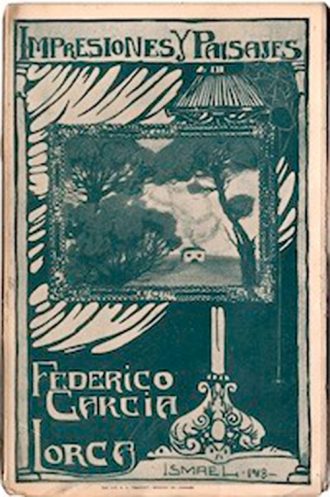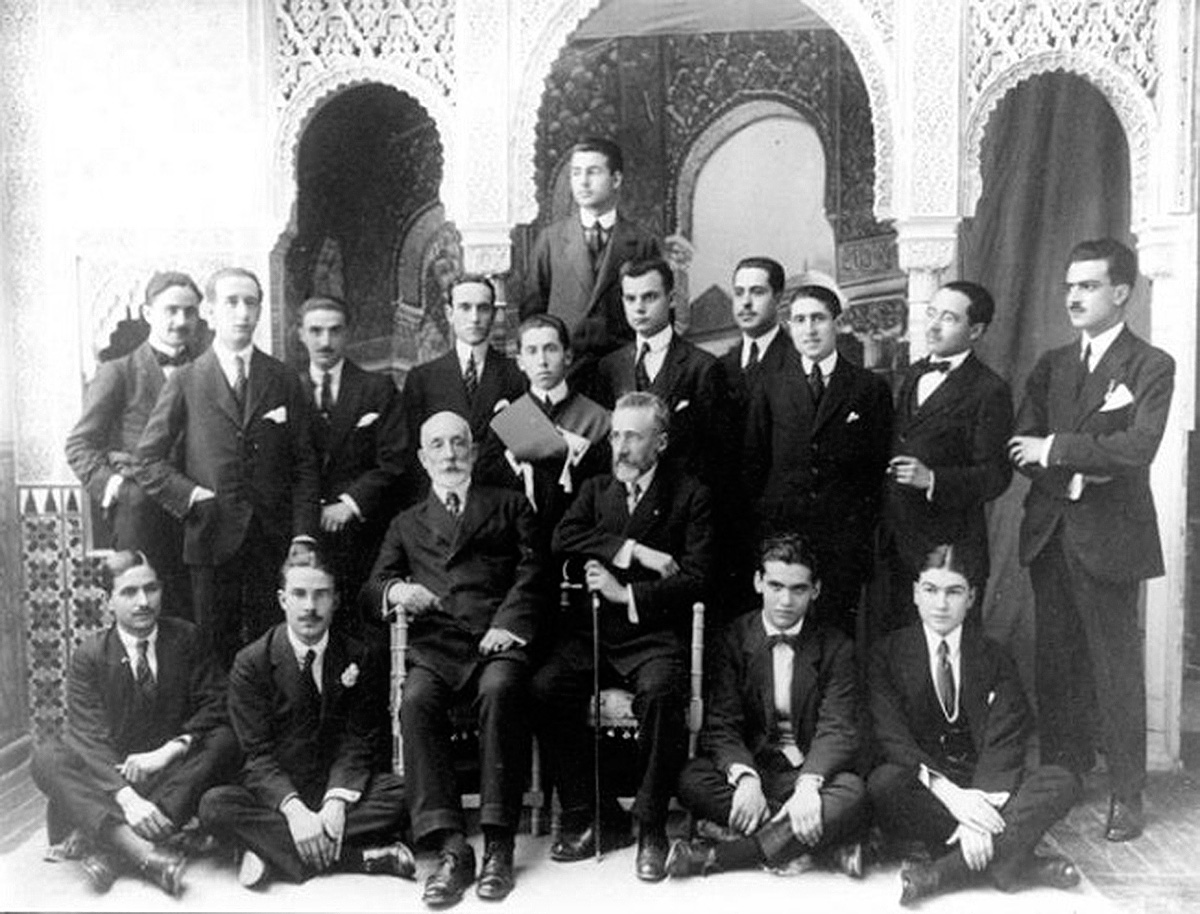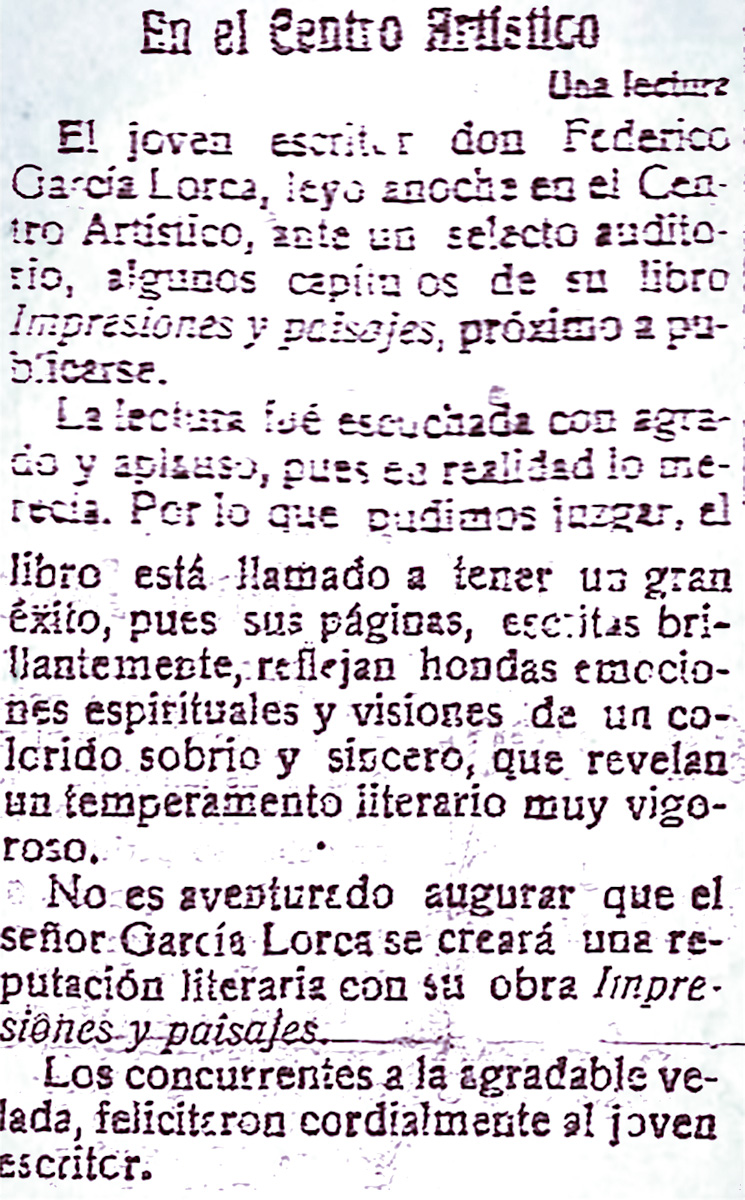
The book Impressions and Landscapes (Impresiones y paisajes) brings together descriptions of different geographical places in Spain through which Lorca passed on his study trip, as well as a series dedicated to Granada, another to gardens and, at the end, a miscellany.
The book opens with a dedication to his former music teacher, Antonio Segura Mesa, and a prolog in which he already expresses his romantic vision of landscape and poetry, as well as his low expectations for the book.
The section Meditation tells us about the fields of Castile and the Castilian cities. He continues with his lyrical vision of the city of Avila, of a Castilian inn, La Cartuja, San Pedro de Cardeña, the Monastery of Silos, the tombs of Burgos…
Of special interest are the sections dedicated to the city of Granada, where the romantic vision of the Albaicín, the Dauro, the criticism on the modifications that the city has suffered (along the lines of Ángel Ganivet), the trace of the city’s oriental past, the contrast between the tranquility of the valley and the tragedy that is breathed in this district (“Everything that the valley and the city have of calm and majestic, this Moorish quarter has of anguish and tragedy”), the Arab evocations, the romantic vision (cypresses of romantic blackness), elements as native of Granada as the pitas, the prickly pears, the ceramics of Fajalauza… The musical lexicon permeates everything (especially the section on Sounds of the City, where the synaesthetic element between sound and color stands out and which recalls his later lecture How a City Sings from November to November).
After the part dedicated to Granada, he adds another to describe the types of gardens and ends with a miscellany and a text, “Missive”, dedicated to his teacher Domínguez Berrueta and to the students with whom he made the trip, and which effectively comes from a missive he sent to them.
After a partial preview in some newspapers and magazines of the time, it was finally published in early April 1918 in Granada, Imprenta y Litografía Paulino Ventura Traveset, with its cover by Ismael González de la Serna. The publication costs were paid by his father, Francisco García Rodríguez. The cover, by Ismael González de la Serna, shows a bucolic scene with a modernist touch.
The first compilation of the complete works (Guillermo de Torre’s edition in Losada, in 1938) only included parts of the book. The Aguilar edition also selects the texts, although the 18th edition, in 1973, already presents it in its entirety. The problem that arises for the editors is, on the one hand, that it is a text before Lorca’s time (according to García-Posada), a document that is only a preview of what would later become his work and that the author himself would not agree to offer. On the other hand, it raises the question of fidelity to the original text, since it presents numerous punctuation and grammatical errors. In addition, the text is also intended for oral communication, and this is noticeable in the music and in the pauses, sometimes marked with commas that are not grammatically correct, although they are correct from a rhythmic point of view. A facsimile edition was made in Granada, Don Quijote publishing house, in 1981.
It was originally entitled Caminatas románticas por la vieja España (Romantic Walks through Old Spain). In his prolog Federico expressed his expectations for the book, to remain for a while in the windows of Granada’s bookstores and then disappear forever. Shortly after, it was he himself who removed it from the bookstores.
It was devised from the study trips that Lorca made through Spain with professor Martín Domínguez Berrueta and other students. On the first trip, on June 6, 1916, they were in Baeza, where Federico met Antonio Machado, and where he was able to hear Antonio recite and play music for him and other students and teachers. They also visited Cordoba and Ronda.
On October 15, 1916 they began a second trip to Madrid, El Escorial, Avila, Medina del Campo, Salamanca, Zamora, Santiago de Compostela, La Coruña, Lugo, León, Burgos and Segovia. In Salamanca he meets Unamuno. On November 8, they arrive in Granada.
It is a fundamental moment in the life of the author, since he was to realize what one of his vocations was, the literary one, which was hidden by the musical one.

Federico García Rodríguez, a little disconcerted by his son’s literary vocation, consulted Luis Seco de Lucena, editor of El Defensor de Granada newspaper, Miguel Cerón and Andrés Segovia, before paying for the publication. After receiving from them the opinion that the book deserved to be published, he accepted and paid for it.
On March 17, 1918, while the book was being printed, he read some excerpts at the Centro Artístico. The evening was a success. El Noticiero Granadino newspaper commented on the poet’s gifts. José Murciano in El eco del aula also published a complementary review, speaking of a Federico capable of moving not only with his music, but with other talents of his such as words.

The book is dedicated to his former music teacher, Antonio Segura Mesa. This provoked the anger of Martín Domínguez Berrueta for ever. Some members of El Rinconcillo did not look very favorably on Domínguez Berrueta. The most critical of him was Mora Guarnido.
Federico did not dedicate the book to Don Martín, even changing the passage about San Bruno de Pereira who was greatly indebted to the professor. Domínguez Berrueta felt betrayed. He only mentioned him and his companions at the end of the book, in a letter. But Don Martín returned the book and never spoke to him again. Even their families, once friends, became estranged. The teacher died two years later and Lorca later acknowledged his debt to him.
Impresiones y paisajes (Impressions and Landscapes) was for Lorca a letter of introduction that brought him, among other things, new friends like Adriano del Valle who praised him for the publication and then asked him for collaboration for the first issue of the Sevillian magazine Grecia. On his arrival in Madrid, at the Residencia de Estudiantes, Federico made copies of his book, which he distributed among the residents.
Along with recollections of Castile, Baeza, Galicia, he added some touches of Granada, some meditations on gardens and other miscellaneous materials. The book conveys a romantic vision of the landscape and is clearly influenced by the modernism of Rubén Darío. The lexicon and musical metaphors are very much present.
The distant mountains emerge with soft reptilian undulations. The infinitely crystalline transparencies show everything in its matte splendor. The shady areas have night in their tangles and the city lazily sheds its veils, revealing its domes and ancient towers illuminated by a soft golden light.
The houses peek their empty-eyed faces through the greenery, and the grasses, poppies, and vine blossoms dance gracefully to the sound of the sun’s breeze.
The shadows are rising and fading languidly, while in the air there is a chirping of ocarinas and reed flutes by the birds.
In the distances there are indecisions of mist and heliotropes of poplars, and sometimes in the morning freshness a distant bleating in the key of F can be heard.
Through the valley of the Dauro, anointed with blue and dark green, fly peasant pigeons, very white and black, to stop on the poplars, or on clumps of yellow flowers.
The grave bells are still asleep, only some albayzinero shearling flutters naively next to a cypress.
The rushes, the reeds, and the fragrant ivy, are leaning towards the water to kiss the sun when you look into it…
The sun appears almost dull…, and at that moment the shadows rise and go…, the city is tinged with pale purple, the mountains become solid gold, and the trees take on gleams of Italian apotheosis.
And all the softness and pallidness of undecided blues change into splendid luminosities, and the ancient towers of the Alhambra are shining with red light…, the houses hurt with their whiteness and the shady areas become brilliant greens.
The sun of Andalusia begins to sing its song of fire that all things hear with awe.
The light is so marvelous and unique that the birds crossing the air are of rare metals, solid irises, and pink opals…
The fumes of the city begin to rise covering it with a heavy fire…, the sun shines and the sky, once pure and fresh, turns dirty white. A windmill begins its sleepy serenade… Some rooster crows remembering the morning sunrise, and the crazy cicadas of the vega play their violins to get drunk at noon…